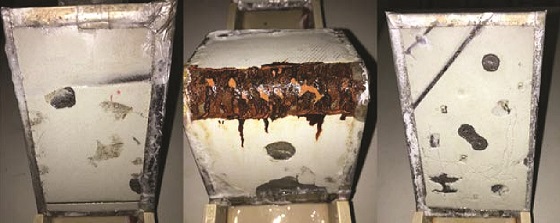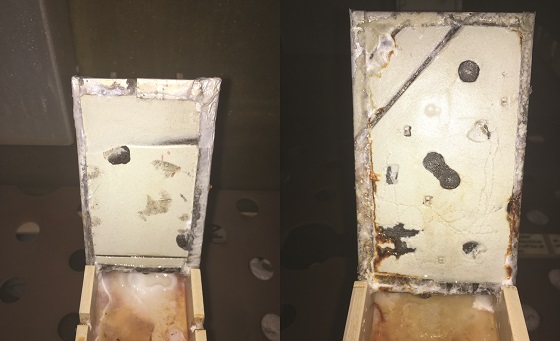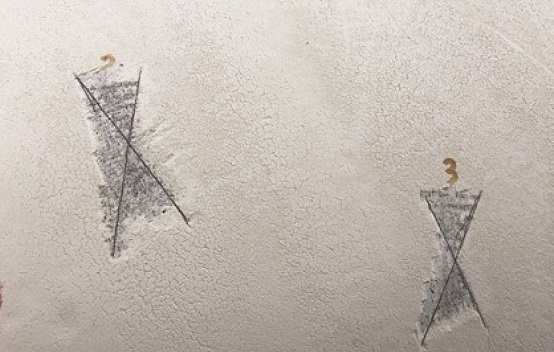Oil and gas major Chevron (San Ramon, California, USA) recently revised its engineering standards to include a novel water-borne spray coating system to protect against both atmospheric corrosion and corrosion under insulation (CUI) at many of its worldwide facilities.
Made by EonCoat (Raleigh, North Carolina, USA), the developer says the inorganic system offers distinct benefits relative to traditional anticorrosion coatings for the high temperatures and corrosive conditions often found in oil and gas environments. When the coating chemically reacts with carbon steel (CS), a protective passivated layer is produced. This protective layer is both insoluble and chemically bonded to the substrate.
“When we talk to oil and gas companies, they want to know that you can use the system both onshore and offshore, for both atmospheric [corrosion] and CUI,” says EonCoat President Merrick Alpert. “They’ll tell you that while atmospheric corrosion is important to them, CUI is urgent for them. It’s what they call the silent killer. So the ability to use this material in a CUI environment—and to know they don’t have corrosion under the insulation blanket—is a huge driver.”
While Alpert would not comment on his company’s work with Chevron, officials with the operating company did detail their trial runs with the system in a recent technical paper and accompanying presentation, delivered at the EUROCORR 2018 conference in September 2018 in Kraków, Poland.1
Technical Advantages
Part A of the two-component coating is based on potassium monophosphate (KH2PO4), and Part B contains magnesium hydroxide [Mg (OH)2]. After spraying, the coating sets in minutes through an acid-base reaction, forming a solid material with an appearance and mechanical properties resembling those of traditional ceramics.
As the coating is sprayed onto CS, the acid converts the top layer of steel into iron phosphate (FePO4) and/or iron magnesium phosphate so that the steel can no longer corrode. The second mechanism for corrosion protection is a cementitious layer, which forms based on the reaction between the acid or acidic salt and the metal oxide. This layer works as a phosphate reservoir by proving phosphate ions to the steel surface for the entire lifetime of the coating.
“In essence, [the system] works by passivating the surface of the substrate so it can no longer react with corrosive substances such as oxygen and moisture,” the operating company writes in its paper. “Unlike paint, it chemically bonds to the surface of the steel. And unlike paint, it is not a barrier coating.”
“Corrosion occurs because you have an active surface,” explains Alpert, referring to the technology of his company’s system and not to any specific case study. “Electrons are going to leave that surface, and if you use a traditional paint, all you’re doing is laying a tarp on it. With this, you’re passivating the surface and sealing off from moisture and oxygen.”
Field and Lab Testing
To better understand the system’s expected performance, the operating company tested the product both in the field and at a third-party laboratory over a three-year period. Using large 5 ft by 7 ft (1.5 m by 2.1 m) panels, the system was evaluated for use in potential atmospheric corrosion conditions at <100 °C, as well as CUI both at low temperatures (<100 °C) and at higher temperatures (up to 350 °C).

Corrosion tests included salt fog testing via ASTM B1172, cyclic corrosion testing under ASTM D58943, and CUI testing. Testing protocols also included various surface preparations, with the NACE No. 3/SSPC-SP 6 “Commercial Blast Cleaning” standard4 found to be most suitable. The testing also confirmed that the system can be applied to flash rusted or rusted surfaces, which the operator says simplifies the surface preparation requirements and lowers the overall cost of application when compared to a standard three-coat system.
To test the system’s mechanical integrity, panels were intentionally damaged. Damage was inflicted in ways such as dropping a ball on the panel; dropping the panel from a height of 3 to 4 m onto cement; using a saw blade to make a cut-like mark into the protective layer; and utilizing a mechanical polisher in some areas. In the most extreme case, one panel was bent at a 90-degree angle. The panels were evaluated after 335 h, and then after 1,870 h.
“In all cases, there is not rust in the areas where the panels were intentionally damaged,” the company writes. “An organic coating would have failed to control the corrosion in these conditions. Where new steel was exposed, that section of the panel rusted, as expected. But notice on the portion of the panel that was bent—at the edge of the coating, there is no rust along the entire line. Meaning, when [the coating] forms a chemical bond with the surface of the steel, the protective layer is formed. When this occurred, the mechanical integrity is maintained.”

Field testing under CUI conditions was done under a longer time period, including a pipe service insulated with blankets and running at temperatures ranging from 120 °C to 138 °C. Four months after performing a cross-cut adhesion into the coating, the system showed no rust.
“Current coating products in the marketplace for CUI provide a very wide temperature range,” the operating company explains. “CUI occurs due to damage to the coating system. If the coating is damaged and insulated, then CUI becomes a very costly inspection and maintenance problem. When damage to the coating system occurs, the damage is not intentional. But it leaves behind an asset integrity problem.”
“What if the tables were turned? What if this layer is not susceptible to mechanical damage? If so, the solution would provide a large number of benefits. First and foremost, the failure mode has changed. It would no longer be the coating failure leading to a corrosion and inspection problem. This mechanical integrity of the protective layer… changes the game for CUI.”
The field testing was conducted at two different geographic locations—one in Richmond, California, and another at its refinery in Pascagoula, Mississippi, on the U.S. Gulf Coast.
“While these two locations differ greatly in both temperature and humidity, the performance results were the same,” the operating company writes. “Salt levels made no difference in performance. Whether the steel was contaminated with salt or the steel was clean, no performance difference was observed.”

Unique Oil, Gas Advantages
Though Alpert could not comment on any specific case study, the president of the coating company says the system offers unique advantages for the oil and gas industry.
“If you look at refineries and marine terminals and where they’re located, a vast majority are by salt or brackish water,” Alpert explains. “That’s a really tough environment for traditional paint to withstand, because effectively, you’ve got salt water, humidity, wind, and significant temperature variations. With us, rather than lay a traditional tarp over it, you’re passivating the steel. Now if it’s an environment that’s dry and indoors, can you use traditional coatings? Sure. But when you’re talking about the core assets of the oil and gas world, like tanks and aboveground pipelines, you need extra protection for those.”
Another significant advantage is reduced turnaround time for operators.5
“With a traditional coating, they might spend a lot of time and money doing the blasting to get it down to near white,” Alpert says. “With this, they just need a basic commercial blast, and then they can apply over flash-rusted steel, damp steel, and steel that has salt on it. If a tank or pipeline section is down, it can cost hundreds of thousands of dollars per day. The ability to turn this around quickly, to reduce the time spent on the blast and the amount of blast media used, and eliminating the intermediate coat of a three-coat system are all advantages that allow you to get the asset back into service very rapidly.”
The system cures within one hour, allowing for the near immediate application of a topcoat for aesthetics. “Because EonCoat is porous, over time it will pick up stains,” Alpert says. “If you use a topcoat, it will prevent that from occurring.” In CUI conditions, where surfaces are not visible, a topcoat is usually not applied since it does not provide functional benefits for the system.
The system is usually applied with a two-part spray gun, though smaller nooks and crannies are often brush applied. “We train the applicator, and we’re there with the applicator for the first job,” Alpert says. “From there, they go out and do it and don’t need us. Our business is to manufacture the coating and to ship it, and we send out the technical support to train and advise the customer’s applicator, who applies the material.”
Based on the anticorrosion properties and application benefits, the developer says momentum for the system should only continue to grow.
“We’re an example of the interconnected nature of the oil and gas industry worldwide,” Alpert says. “It’s fascinating that when a best practice is developed, particularly when it’s driven by a new technology, these majors so closely follow what the others do. The moment that it’s out there publicly, they’re on it. These people communicate with one another. It’s really fascinating to see how the world can be such a small place.”
Source: EonCoat, www.eoncoat.com. Contact Merrick Alpert, EonCoat—e-mail: merrick.alpert@eoncoat.com.
References
1 B. Chaloner-Gill, et al., “Chevron’s Use of EonCoat to Prevent Corrosion on Steel,” EUROCORR 2018, Sept. 11, 2018, https://eurocorr2018.org/upload/EuroCorr-2018/Chevron's-Use-of-EonCoat-To-Permanently-Prevent-Corrosion-On-Steel.pdf (Nov. 28, 2018).
2 ASTM B117-18, “Standard Practice for Operating Salt Spray (Fog) Apparatus” (West Conshohocken, PA: ASTM International, 2018).
3 ASTM D5894-16, “Standard Practice for Cyclic Salt Fog/UV Exposure of Painted Metal (Alternating Exposures in a Fog/Dry Cabinet and a UV/Condensation Cabinet)” (West Conshohocken, PA: ASTM, 2016).
4 NACE No. 3/SSPC-SP 6, “Commercial Blast Cleaning” (Houston, TX: NACE).
5 K. Riggs Larsen, “Chemically Bonded Phosphate Ceramics Provide Corrosion Protection for Storage Tanks.” MP 55, 6, http://www.materialsperformance.com/articles/material-selection-design/2016/06/chemically-bonded-phosphate-ceramics-provide-corrosion-protection-for-storage-tanks (Nov. 28, 2018).